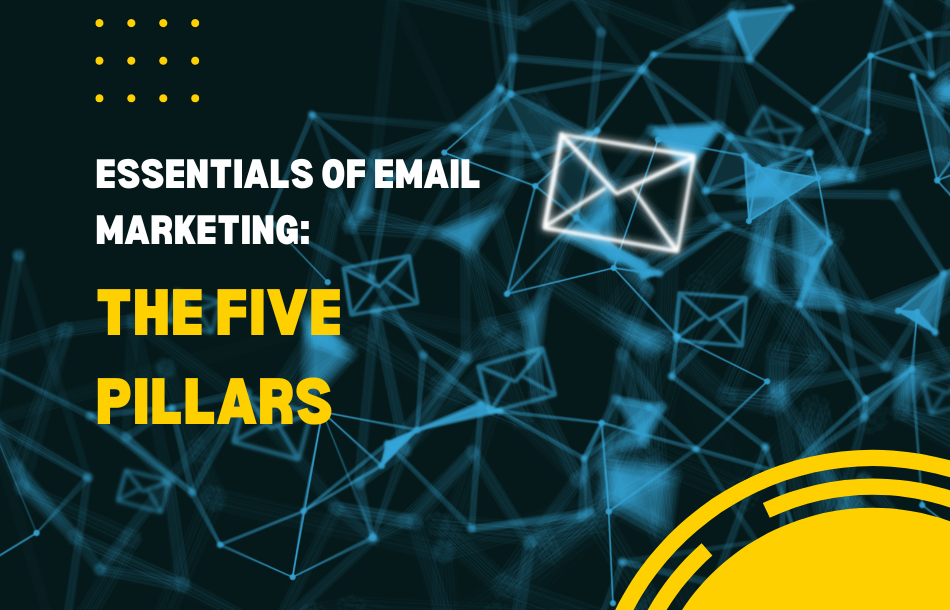Essentials of email marketing: the five pillars

1. Make an statement with your subject line
- "Hey [Name], Your Personalized Weekly Deals Are Here!"
- "Exclusive Savings Inside for Our Valued Customers!"
The first subject line is more effective due to several reasons:
Direct Personalization: It directly addresses the recipient by name ("Hey [Name]"). This personal touch can make the email feel more like a one-on-one conversation rather than a mass message, increasing the likelihood of the recipient opening the email.
Specific Offering: It mentions "Your Personalized Weekly Deals," suggesting that the content inside is tailored specifically for the recipient. This level of customization can make the offer more appealing.
Clarity and Relevance: The subject line is clear about what the email contains ("Weekly Deals"), which can be more engaging for recipients looking for bargains or interested in regular updates.
On the other hand, the second subject line is less creative but yet interesting. It might be less persuasive because it doesn't mention that the offers are customized and doesn't use the recipient's name.
2. Setting up your email the right way
Consider the vibe you give off as the sender. You want to appear professional and avoid sending emails that wind up in the spam bin. Here's how you do it:
Pick a proper email name: Skip those boring "no-reply" addresses. They just shout "robot" and don't really build trust. Go for a regular business-like email name instead. It feels more human and helps your emails get through to people.
Thumbs up for something like t[email protected] or eliza.walker@lokasales.com. Big no-no for stuff like [email protected] or [email protected].
Nail your signature: Your email signature is like your digital business card. It should show off who you are and what you're about. Make sure to include your name, job title, company, and how to reach you. And here's a couple of tips:
If you're sending friendly or marketing emails, don't be hesitant to include your photo and any nice awards you've received. You can also include a link to your own website.
Mailbox configuration: Set up your SPF, DKIm, and DMARC records as a technical step before you begin sending transactional and marketing emails. In addition, you must verify your domain.3. Domain warmup
4. Talk about needs and offer solutions
Here's an example:
Subject Line: [Recipient's Name], Overcome Your Project Management Challenges Today!
From: [email protected]
Dear [Recipient's Name],
I hope this email finds you well. I noticed that your company, [Company Name], has recently embarked on some ambitious projects. It's impressive, but I can imagine that managing these projects efficiently is quite a challenge.
Are you finding it difficult to keep track of deadlines and team responsibilities? You're not alone. Many of our clients at Productivity Solutions faced similar issues before they found our project management tool, EasyManage.
EasyManage is designed to streamline your workflow and enhance team collaboration. With our tool, you can effortlessly track progress, assign tasks, and meet your deadlines without the usual stress.
I'd love to show you how EasyManage can specifically benefit [Company Name]. Are you available for a quick 15-minute call next week? I can share some insights on how other companies in your industry have improved their project management with our tool.
Looking forward to hearing from you.
Best regards,
Jordan Lee Senior Account Manager Productivity Solutions Email: [email protected] Phone: [Your Phone Number] [Optional: Link to LinkedIn Profile or Company Website]
6. Relevant and Valuable Content
Subject: Quick Solutions for [Company Name]'s Efficiency Challenges
From: [email protected]
Hi [Recipient's Name],
Hope you're doing well. After our last chat about [Company Name]'s project efficiency issues, I wanted to share a quick resource. Check out this case study where we helped a similar company: [Link to Case Study]. It might give you some useful insights.
Also, this blog post, "5 Strategies to Boost Team Efficiency," could offer some practical tips for your team: [Link to Blog Post].
If you'd like to discuss tailored solutions for [Company Name], how about a call next Tuesday?
Best,
Alex Taylor Client Solutions Specialist, Efficient Business Solutions [email protected] | [Phone Number]

